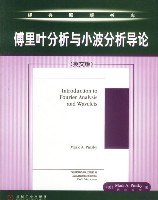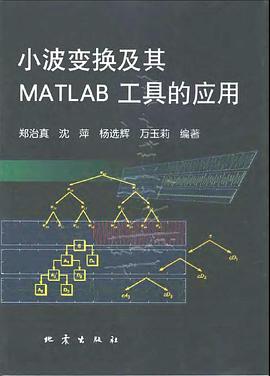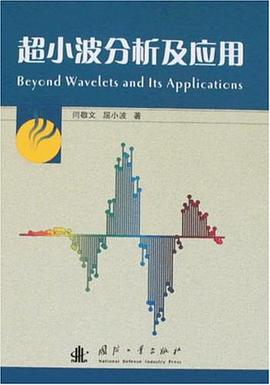

具体描述
本书是由一位成功的数学家用传统的表述形式编写的教材,除了主要介绍傅里叶级数和傅里叶分析外,还讨论了另一类可以通过傅里叶方法进行研究的正交级数,即小波分析。
本书可以作为理工类专业高年级本科生和低年级研究生的教材。
本书特点:
·书中的所有命题、引理、定理和推论都给出了严格的证明
·某些情况下,对于一个给定的命题,给出几种证明方法,使学生可以对不同方法进行比较
·不属于傅里叶分析主流题材但与本书有特定联系的论题,在带有*号的小节中讲述
·理论和实践相结合
作者简介
目录信息
1 FOURIER SERIES ON THE CIRCLE
1.1 Motivation and Heuristics
1.1.1 Motivation from Physics
1.1.1.1 The Vibrating String
1.1.1.2 Heat Flow in Solids
1.1.2 Absolutely Convergent Trigonometric Series
1.1.3 *Examples of Factorial and Bessel Functions
1.1.4 Poisson Kernel Example
1.1.5 *Proof of Laplace's Method
1.1.6 *Nonabsolutely Convergent Trigonometric Series
1.2 Formulation of Fourier Series
1.2.1 Fourier Coefficients and Their Basic Properties
1.2.2 Fourier Series of Finite Measures
1.2.3 *Rates of Decay of Fourier Coefficients
1.2.3.1 Piecewise Smooth Functions
1.2.3.2 Fourier Characterization of Analytic Functions
1.2.4 Sine Integral
1.2.4.1 Other Proofs That Si( ) =l
1.2.5 Pointwise Convergence Criteria
1.2.6 *Integration of Fourier Series
1.2.6.1 Convergence of Fourier Series of Measures
1.2.7 Riemann Localization Principle
1.2.8 Gibbs-Wilbraham Phenomenon
1.2.8.l The General Case
1.3 Fourier Series in L2
1.3.l Mean Square Approximation-Parseval's Theorem
1.3.2 *Application to the Isoperimetric Inequality
1.3.3 *Rates of Convergence in L2
1.3.3.1 Application to Absolutely-Convergent Fourier
Series
1.4 Norm Convergence and Summability
1.4.1 Approximate Identities
1.4.1.1 Almost-Everywhere Convergence of the Abel
Means
1.4.2 Summability Matrices
l.4.3 Fejer Means of a Fourier Series
1.4.3.1 Wiener's Closure Theorem on the Circle
1.4.4 *Equidistribution Modulo One
1.4.5 *Hardy's Tauberian Theorem
1.5 Improved Trigonometric Approximation
1.5.1 Rates of Convergence in C(T)
1.5.2 Approximation with Fejer Means
1.5.3 *Jackson's Theorem
1.5.4 *Higher-Order Approximation
1.5.5 *Converse Theorems of Bernstein
1.6 Divergence of Fourier Series
1.6.1 The Example of du Bois-Reymond
1.6.2 Analysis via Lebesgue Constants
1.6.3 Divergence in the Space L1
1.7 *Appendix: Complements on Laplace's Method
1.7.O.l First Variation on the Theme-Gaussian
Approximation
1.7.0.2 Second Variation on the Theme-Improved Error
Estimate
1.7.l *Application to Bessel Functions
1.7.2 *The Local Limit Theorem of DeMoivre-Laplace
1.8 Appendix: Proof of the Uniform Boundedness Theorem
1.9 *Appendix: Higher-Order Bessel functions
1.10 Appendix: Cantor's Uniqueness Theorem
2 FOURIER TRANSFORMS ON THE LINE AND SPACE
2.1 Motivation and Heuristics
2.2 Basic Properties of the Fourier Transform
2.2.l Riemann-Lebesgue Lemma
2.2.2 Approximate Identities and Gaussian Summability
2.2.2.1 Improved Approximate Identities for Pointwise
Convergence
2.2.2.2 Application to the Fourier Transform
2.2.2.3 The n-Dimensional Poisson Kernel
2.2.3 Fourier Transforms of Tempered Distributions
2.2.4 *Characterization of the Gaussian Density
2.2.5 *Wiener's Density Theorem
2.3 Fourier Inversion in One Dimension
2.3.1 Dirichlet Kernel and Symmetric Partial Sums
2.3.2 Example of the Indicator Function
2.3.3 Gibbs-Wilbraham Phenomenon
2.3.4 Dini Convergence Theorem
2.3.4.1 Extension to Fourier's Single Integral
2.3.5 Smoothing Operations in R1-Averaging and Summability
2.3.6 Averaging and Weak Convergence
2.3.7 Cesaro Summability
2.3.7.1 Approximation Propenies of the Fejer Kernel
2.3.8 Bemstein's Inequality
2.3.9 *One-Sided Fourier Integral Representation
2.3.9.1 Fourier Cosine Transform
2.3.9.2 Fourier Sine Transform
2.3.9.3 Generalized h-Transform
2.4 L2 Theory in Rn
2.4.1 Plancherel's Theorem
2.4.2 *Bernstein's Theorem for Fourier Transforms
2.4.3 The Uncertainty Principle
2.4.3.l Uncertainty Principle on the Circle
2.4.4 Spectral Analysis of the Fourier Transform
2.4.4.1 Hermite Polynomials
2.4.4.2 Eigenfunction of the Fourier Transform
2.4.4.3 Orthogonality Properties
2.4.4.4 Completeness
2.5 Spherical Fourier Inversion in Rn
2.5.l Bochner's Approach
2.5.2 Piecewise Smooth Viewpoint
2.5.3 Relations with the Wave Equation
2.5.3.l The Method of Brandolini and Colzani
2.5.4 Bochner-Riesz Summability
2.5.4.l A General Theorem on Almost-Everywhere
Summability
2.6 Bessel Functions
2.6.l Fourier Transforms of Radial Functions
2.6.2 L2-Restriction Theorems for ate Fourier Transform
2.6.2.l An Improved Result
2.6.2.2 Limitations on the Range of p
2.7 The Method of Stationary Phase
2.7.l Statement of the Result
2.7.2 Application to Bessel Functions
2.7.3 Proof of the Method of Stationary Phase
2.7.4 Abel's Lemma
3 FOURIER ANALYSIS IN LP SPACES
3.l Motivation and Heuristics
3.2 The M.Riesz-Thorin Interpolation Theorem
3.2.0.l Generalized Young's Inequality
3.2.0.2 The Hausdorff-Young Inequality
3.2.l Stein's Complex Interpolation Theorem
3.3 The Conjugate Function or Discrete Hilbert Transform
3.3.1 LP Theory of the Conjugate Function
3.3.2 L1 Theory of the Conjugate Function
3.3.2.l Identification as a Singular Integral
3.4 The Hilbert Transform on R
3.4.l L2 Theory of the Hilbert Transform
3.4.2 Lp Theory of the Hilbert Transform.l [ P [
3.4.2.l Applications to Convergence of Fourier Integrals
3.4.3 L1 Theory of the Hilbert Transform and Extensions
3.4.3.l Kolmogorov's Inequality for the Hilbert
Transform
3.4.4 Application to Singular Integrals with Odd Kernels
3.5 Hardy-Littlewood Maximal Function
3.5.l Application to the Lebesgue Differentiation Theorem
3.5.2 Application to Radial Convolution Operators
3.5.3 Maximal Inequalities for Spherical Averages
3.6 The Marcinkiewicz Interpolation Theorem
3.7 Calderon-Zygmund Decomposition
3.8 A Class of Singular Integrals
3.9 Propenies of Harmonic Functions
3.9.l General Properties
3.9.2 Representation Theorems in the Disk
3.9.3 Representation Theorems in the Upper Half-Plane
3.9.4 Herglotz/Bochner Theorems and Positive Definite
Functions
4 POISSON SUMMATION FORMULA AND
MULTIPLE FOURIER SERIES
4.l Motivation and Heudstics
4.2 The Poisson Summation Formula in R1
4.2.1 Periodization of a Function
4.2.2 Statement and Proof
4.2.3 Shannon Sampling
4.3 Multiple Fourier Series
4.3.l Basic L1 Theory
4.3.1.1 Pointwise Convergence for Smooath Functions
4.3.1.2 Representation of Spherical Partial Sums
4.3.2 Basic L2 Theory
4.3.3 Restriction Theorems for Fourier Coefficients
4.4 Poisson Summation Formula in Rd
4.4.1 *Simultaneous Nonlocalization
4.5 Application to Lattice Points
4.5.l Kendall's Mean Square Error
4.5.2 Landau's Asymptotic Formula
4.5.3 Application to Multiple Fourier Series
4.5.3.1 Three-Dimensional Case
4.5.3.2 Higher-Dimensional Case
4.6 Schrodinger Equation and Gauss Sums
4.6.l Distibutions on the Circle
4.6.2 The Schrodinger Equation on the Circle
4.7 Recurrence of Random Walk
5 APPLICATIONS TO PROBABILITY THEORY
5.l Motivation and Heuristics
5.2 Basic Definitions
5.2.1 The Central Limit Theorem
5.2.1.1 Restatement in Terms of Independent
Random Variables
5.3 Extension to Gap Series
5.3.l Extension to Abel Sums
5.4 Weak Convergence of Measures
5.4.l An Improved Continuity Theorem
5.4.l.l Another Proof of Bochner's Theorem
5.5 Convolution Semigroups
5.6 The Berry-Esseen Theorem
5.6.l Extension to Different Distributions
5.7 The Law of the Iterated Logarithm
6 INTRODUCTION TO WAVELETS
6.l Motivation and Heuristics
6.l.1 Heuristic Treatment of the Wavelet Transform
6.2 Wavelet Transform
6.2.0.l Wavelet Characterization of Smoothness
6.3 Haar Wavelet Expansion
6.3.l Haar Functions and Haar Series
6.3.2 Haar Sums and Dyadic Projections
6.3.3 Completeness of the Haar Functions
6.3.3.1 Haar Series in Co and Lp Spaces
6.3.3.2 Pointwise Convergence of Haar Series
6.3.4 *Construction of Standard Brownian Motion
6.3.5 *Haar Function Representation of Brownian Motion
6.3.6 *Proof of Continuity
6.3.7 *Levy's Modulus of Continuity
6.4 Multiresolution Analysis
6.4.l Orthonormal Systems and Riesz Systems
6.4.2 Scaling Equations and Structure Constants
6.4.3 From Scaling Function to MRA
6.4.3.l Additional Remarks
6.4.4 Meyer Wavelets
6.4.5 From Scaling Function to Orthonormal Wavelet
6.4.5.1 Direct Proof that V1 V0 Is Spanned by
{ (t-k)}k
6.4.5.2 Null Integrability of Wavelets Without-
Scaling Functions
6.5 Wavelets with Compact Support
6.5.l From Scaling Filter to Scaling Function
6.5.2 Explicit Construction of Compact Wavelets
6.5.2.l Daubechies Recipe
6.5.2.2 Hemandez-Weiss Recipe
6.5.3 Smoothness of Wavelets
6.5.3.l A Negative Result
6.5.4 Cohen's Extension of Theorem 6.5.1
6.6 Convergence Properties of Wavelet Expansions
6.6.1 Wavelet Series in Lp Spaces
6.6.1.1 Large Scale Analysis
6.6.1.2 Almost-Everywhere Convergence
6.6.1.3 Convergence at a Preassigned Point
6.6.2 Jackson and Bernstein Approximation Theorems
6.7 Wavelets in Several Variables
6.7.1 Two Important Examples
6.7.l.l Tensor Product of Wavelets
6.7.2 General Formulation of MRA and Wavelets in Rd
6.7.2.l Notations for Subgroups and Cosets
6.7.2.2 Riesz Systems and Orhonormal Systems in Rd
6.7.2.3 Scaling Equation and Structure Constants
6.7.2.4 Existence of the Wavelet Set
6.7.2.5 Proof That the Wavelet Set Spans V1 V0
6.7.2.6 Cohen's Theorem in Rd
6.7.3 Examples of Wavelets in Rd
References
Notations
Index
· · · · · · (收起)
1.1 Motivation and Heuristics
1.1.1 Motivation from Physics
1.1.1.1 The Vibrating String
1.1.1.2 Heat Flow in Solids
1.1.2 Absolutely Convergent Trigonometric Series
1.1.3 *Examples of Factorial and Bessel Functions
1.1.4 Poisson Kernel Example
1.1.5 *Proof of Laplace's Method
1.1.6 *Nonabsolutely Convergent Trigonometric Series
1.2 Formulation of Fourier Series
1.2.1 Fourier Coefficients and Their Basic Properties
1.2.2 Fourier Series of Finite Measures
1.2.3 *Rates of Decay of Fourier Coefficients
1.2.3.1 Piecewise Smooth Functions
1.2.3.2 Fourier Characterization of Analytic Functions
1.2.4 Sine Integral
1.2.4.1 Other Proofs That Si( ) =l
1.2.5 Pointwise Convergence Criteria
1.2.6 *Integration of Fourier Series
1.2.6.1 Convergence of Fourier Series of Measures
1.2.7 Riemann Localization Principle
1.2.8 Gibbs-Wilbraham Phenomenon
1.2.8.l The General Case
1.3 Fourier Series in L2
1.3.l Mean Square Approximation-Parseval's Theorem
1.3.2 *Application to the Isoperimetric Inequality
1.3.3 *Rates of Convergence in L2
1.3.3.1 Application to Absolutely-Convergent Fourier
Series
1.4 Norm Convergence and Summability
1.4.1 Approximate Identities
1.4.1.1 Almost-Everywhere Convergence of the Abel
Means
1.4.2 Summability Matrices
l.4.3 Fejer Means of a Fourier Series
1.4.3.1 Wiener's Closure Theorem on the Circle
1.4.4 *Equidistribution Modulo One
1.4.5 *Hardy's Tauberian Theorem
1.5 Improved Trigonometric Approximation
1.5.1 Rates of Convergence in C(T)
1.5.2 Approximation with Fejer Means
1.5.3 *Jackson's Theorem
1.5.4 *Higher-Order Approximation
1.5.5 *Converse Theorems of Bernstein
1.6 Divergence of Fourier Series
1.6.1 The Example of du Bois-Reymond
1.6.2 Analysis via Lebesgue Constants
1.6.3 Divergence in the Space L1
1.7 *Appendix: Complements on Laplace's Method
1.7.O.l First Variation on the Theme-Gaussian
Approximation
1.7.0.2 Second Variation on the Theme-Improved Error
Estimate
1.7.l *Application to Bessel Functions
1.7.2 *The Local Limit Theorem of DeMoivre-Laplace
1.8 Appendix: Proof of the Uniform Boundedness Theorem
1.9 *Appendix: Higher-Order Bessel functions
1.10 Appendix: Cantor's Uniqueness Theorem
2 FOURIER TRANSFORMS ON THE LINE AND SPACE
2.1 Motivation and Heuristics
2.2 Basic Properties of the Fourier Transform
2.2.l Riemann-Lebesgue Lemma
2.2.2 Approximate Identities and Gaussian Summability
2.2.2.1 Improved Approximate Identities for Pointwise
Convergence
2.2.2.2 Application to the Fourier Transform
2.2.2.3 The n-Dimensional Poisson Kernel
2.2.3 Fourier Transforms of Tempered Distributions
2.2.4 *Characterization of the Gaussian Density
2.2.5 *Wiener's Density Theorem
2.3 Fourier Inversion in One Dimension
2.3.1 Dirichlet Kernel and Symmetric Partial Sums
2.3.2 Example of the Indicator Function
2.3.3 Gibbs-Wilbraham Phenomenon
2.3.4 Dini Convergence Theorem
2.3.4.1 Extension to Fourier's Single Integral
2.3.5 Smoothing Operations in R1-Averaging and Summability
2.3.6 Averaging and Weak Convergence
2.3.7 Cesaro Summability
2.3.7.1 Approximation Propenies of the Fejer Kernel
2.3.8 Bemstein's Inequality
2.3.9 *One-Sided Fourier Integral Representation
2.3.9.1 Fourier Cosine Transform
2.3.9.2 Fourier Sine Transform
2.3.9.3 Generalized h-Transform
2.4 L2 Theory in Rn
2.4.1 Plancherel's Theorem
2.4.2 *Bernstein's Theorem for Fourier Transforms
2.4.3 The Uncertainty Principle
2.4.3.l Uncertainty Principle on the Circle
2.4.4 Spectral Analysis of the Fourier Transform
2.4.4.1 Hermite Polynomials
2.4.4.2 Eigenfunction of the Fourier Transform
2.4.4.3 Orthogonality Properties
2.4.4.4 Completeness
2.5 Spherical Fourier Inversion in Rn
2.5.l Bochner's Approach
2.5.2 Piecewise Smooth Viewpoint
2.5.3 Relations with the Wave Equation
2.5.3.l The Method of Brandolini and Colzani
2.5.4 Bochner-Riesz Summability
2.5.4.l A General Theorem on Almost-Everywhere
Summability
2.6 Bessel Functions
2.6.l Fourier Transforms of Radial Functions
2.6.2 L2-Restriction Theorems for ate Fourier Transform
2.6.2.l An Improved Result
2.6.2.2 Limitations on the Range of p
2.7 The Method of Stationary Phase
2.7.l Statement of the Result
2.7.2 Application to Bessel Functions
2.7.3 Proof of the Method of Stationary Phase
2.7.4 Abel's Lemma
3 FOURIER ANALYSIS IN LP SPACES
3.l Motivation and Heuristics
3.2 The M.Riesz-Thorin Interpolation Theorem
3.2.0.l Generalized Young's Inequality
3.2.0.2 The Hausdorff-Young Inequality
3.2.l Stein's Complex Interpolation Theorem
3.3 The Conjugate Function or Discrete Hilbert Transform
3.3.1 LP Theory of the Conjugate Function
3.3.2 L1 Theory of the Conjugate Function
3.3.2.l Identification as a Singular Integral
3.4 The Hilbert Transform on R
3.4.l L2 Theory of the Hilbert Transform
3.4.2 Lp Theory of the Hilbert Transform.l [ P [
3.4.2.l Applications to Convergence of Fourier Integrals
3.4.3 L1 Theory of the Hilbert Transform and Extensions
3.4.3.l Kolmogorov's Inequality for the Hilbert
Transform
3.4.4 Application to Singular Integrals with Odd Kernels
3.5 Hardy-Littlewood Maximal Function
3.5.l Application to the Lebesgue Differentiation Theorem
3.5.2 Application to Radial Convolution Operators
3.5.3 Maximal Inequalities for Spherical Averages
3.6 The Marcinkiewicz Interpolation Theorem
3.7 Calderon-Zygmund Decomposition
3.8 A Class of Singular Integrals
3.9 Propenies of Harmonic Functions
3.9.l General Properties
3.9.2 Representation Theorems in the Disk
3.9.3 Representation Theorems in the Upper Half-Plane
3.9.4 Herglotz/Bochner Theorems and Positive Definite
Functions
4 POISSON SUMMATION FORMULA AND
MULTIPLE FOURIER SERIES
4.l Motivation and Heudstics
4.2 The Poisson Summation Formula in R1
4.2.1 Periodization of a Function
4.2.2 Statement and Proof
4.2.3 Shannon Sampling
4.3 Multiple Fourier Series
4.3.l Basic L1 Theory
4.3.1.1 Pointwise Convergence for Smooath Functions
4.3.1.2 Representation of Spherical Partial Sums
4.3.2 Basic L2 Theory
4.3.3 Restriction Theorems for Fourier Coefficients
4.4 Poisson Summation Formula in Rd
4.4.1 *Simultaneous Nonlocalization
4.5 Application to Lattice Points
4.5.l Kendall's Mean Square Error
4.5.2 Landau's Asymptotic Formula
4.5.3 Application to Multiple Fourier Series
4.5.3.1 Three-Dimensional Case
4.5.3.2 Higher-Dimensional Case
4.6 Schrodinger Equation and Gauss Sums
4.6.l Distibutions on the Circle
4.6.2 The Schrodinger Equation on the Circle
4.7 Recurrence of Random Walk
5 APPLICATIONS TO PROBABILITY THEORY
5.l Motivation and Heuristics
5.2 Basic Definitions
5.2.1 The Central Limit Theorem
5.2.1.1 Restatement in Terms of Independent
Random Variables
5.3 Extension to Gap Series
5.3.l Extension to Abel Sums
5.4 Weak Convergence of Measures
5.4.l An Improved Continuity Theorem
5.4.l.l Another Proof of Bochner's Theorem
5.5 Convolution Semigroups
5.6 The Berry-Esseen Theorem
5.6.l Extension to Different Distributions
5.7 The Law of the Iterated Logarithm
6 INTRODUCTION TO WAVELETS
6.l Motivation and Heuristics
6.l.1 Heuristic Treatment of the Wavelet Transform
6.2 Wavelet Transform
6.2.0.l Wavelet Characterization of Smoothness
6.3 Haar Wavelet Expansion
6.3.l Haar Functions and Haar Series
6.3.2 Haar Sums and Dyadic Projections
6.3.3 Completeness of the Haar Functions
6.3.3.1 Haar Series in Co and Lp Spaces
6.3.3.2 Pointwise Convergence of Haar Series
6.3.4 *Construction of Standard Brownian Motion
6.3.5 *Haar Function Representation of Brownian Motion
6.3.6 *Proof of Continuity
6.3.7 *Levy's Modulus of Continuity
6.4 Multiresolution Analysis
6.4.l Orthonormal Systems and Riesz Systems
6.4.2 Scaling Equations and Structure Constants
6.4.3 From Scaling Function to MRA
6.4.3.l Additional Remarks
6.4.4 Meyer Wavelets
6.4.5 From Scaling Function to Orthonormal Wavelet
6.4.5.1 Direct Proof that V1 V0 Is Spanned by
{ (t-k)}k
6.4.5.2 Null Integrability of Wavelets Without-
Scaling Functions
6.5 Wavelets with Compact Support
6.5.l From Scaling Filter to Scaling Function
6.5.2 Explicit Construction of Compact Wavelets
6.5.2.l Daubechies Recipe
6.5.2.2 Hemandez-Weiss Recipe
6.5.3 Smoothness of Wavelets
6.5.3.l A Negative Result
6.5.4 Cohen's Extension of Theorem 6.5.1
6.6 Convergence Properties of Wavelet Expansions
6.6.1 Wavelet Series in Lp Spaces
6.6.1.1 Large Scale Analysis
6.6.1.2 Almost-Everywhere Convergence
6.6.1.3 Convergence at a Preassigned Point
6.6.2 Jackson and Bernstein Approximation Theorems
6.7 Wavelets in Several Variables
6.7.1 Two Important Examples
6.7.l.l Tensor Product of Wavelets
6.7.2 General Formulation of MRA and Wavelets in Rd
6.7.2.l Notations for Subgroups and Cosets
6.7.2.2 Riesz Systems and Orhonormal Systems in Rd
6.7.2.3 Scaling Equation and Structure Constants
6.7.2.4 Existence of the Wavelet Set
6.7.2.5 Proof That the Wavelet Set Spans V1 V0
6.7.2.6 Cohen's Theorem in Rd
6.7.3 Examples of Wavelets in Rd
References
Notations
Index
· · · · · · (收起)
读后感
评分
评分
评分
评分
评分
用户评价
评分
评分
评分
评分
评分
相关图书
本站所有内容均为互联网搜索引擎提供的公开搜索信息,本站不存储任何数据与内容,任何内容与数据均与本站无关,如有需要请联系相关搜索引擎包括但不限于百度,google,bing,sogou 等
© 2025 book.quotespace.org All Rights Reserved. 小美书屋 版权所有




















